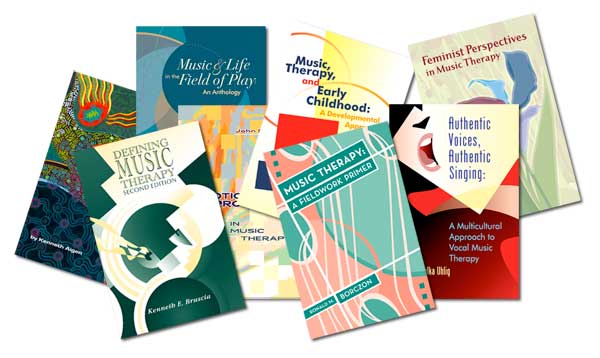I could go on and on about what instruments I think I need, but I have to say that I am preoccupied by needing and even wanting a 3/4 dreadnought, also known as a “baby” Taylor or Martin. 
Motivation
Working in private practice offers its set of challenges. One such challenge, for me, is finding consistent motivation to KEEP UP ON MY PAPERWORK. I’m actually pretty scheduled and somewhat determined, and definitely goal-oriented. But, my lists and post-its and planners and web-based calendars amass entries much faster than I can strike them (or recycle them, in the case of my post-its).
Today, I figured it out. Today, I felt productive. Today, I drank twice the amount of coffee as usual — and continued drinking it well into the dark of mid-afternoon (I hate these short days) — and today, I see a space in the lineup of paper product piles assigned to to-dos.
Books in abundance
I was listening to Janice Lindstrom’s latest episode of The Music Therapy Show today, in which she interviewed Barbara Wheeler, PhD, MT-BC, and decided two things:
- Maybe I’d read more music therapy research and texts if they were available on an e-reader (and oh hey, at Barcelona Publishers, texts are available in abundance in that format).
- Maybe I could do with starting a music therapy book- or text- or research- or novel-reading club. Any interest?
Two small business blogs
Because I’ve had such a terrifically long day, I’m going to keep this short and leave you with two blogs that I find helpful in small business development and growth. They are Private Practice from the Inside Out and Small Biz Lady.
Have a good Thursday.
Music, the co-therapist
Music is such a great co-therapist. What a revelation for a music therapist to have.
I can know this, and have known it intellectually, for years, but much of the time I have trouble trusting that the music in my music therapy sessions works more effectively than anything else.
One of my clients tonight had a lot of trouble transitioning into our session together. So much so that he balled himself up into a chair and decidedly did not communicate with me, verbally or otherwise. I sat with him in quiet before laying out a number of instruments, including the drum sets and kits on GarageBand (a favorite of his). I then played piano for a few minutes before he unwrapped himself and explored the instruments in front of him. Soon we had a conversation on our instruments, and I’ve never felt more connected to this client than I did tonight. Though he’s able to communicate verbally and has done so unabashedly in the past, we related to one another differently, and seemingly more clearly, tonight.
It’s nice to have another therapist in the room.
Another shift
I am beginning something of a transition in my approach to my music therapy work. I’m beginning to shift my perspective into a process oriented approach.
The most poignant thought I took away from clinical supervision tonight, and the realization that I hope to focus on throughout this next week, is, “Because I am asking my clients to use music to express, communicate, relate, and learn, I should use music in the same way.” I don’t use music. I make it for purposes of providing music therapy sessions, but I do not use music in those ways.
Perhaps I will.
“Special Ed”
I do have a fantastic love for podcasts. One that has always been playing through my speakers is “This American Life.” I imagine you’ve heard it. A few weeks ago, the podcast rebroadcast the below episode called “Special Ed.” Take a listen.
“Boléro” in the morning
I have always had trouble listening to music unless it is for a specific reason. Sometimes that reason is for research, sometimes it’s to keep me at a certain pace while exercising, and of course sometimes it’s to change or augment my mood.
I came across the idea of creating a “waking playlist” (as I like to call it) or a playlist to hear in the morning which has the function of staging the coming day. I read about this in a couple of different music therapists’ blogs, and I really like the idea. The first piece that I choose for mine is “Boléro” by Ravel. I discovered this piece when I was in fifth grade, and have adored it since.
Recently I heard a Radiolab podcast called, “Unraveling Bolero,” in which the hosts reported on a very unusual story involving one Anne Adams, a biologist whose path resembled Ravel’s in a peculiar way. Here is a synopsis of the episode:
At some point, Anne became obsessed with Maurice Ravel’s famous composition and decided to put an elaborate visual rendition of the song to canvas. She called it “Unraveling Bolero.” But at the time, she had no idea that both she and Ravel would themselves unravel shortly after their experiences with this odd piece of music. Arbie Orenstein tells Jad what happened to Ravel after he wrote “Bolero,” and neurologist Bruce Miller and Jonah Lehrer helps us understand how, for both Anne and Ravel, “Bolero” might have been the first symptom of a deadly disease.
Find “Unraveling Bolero” here:
One for two
I’ve decided to add another challenge to my days this week. Not only am I busy planning my wedding, but I’ve decided I need to direct more energy at my musical skill development. I’ve challenged myself to writing one song (defined, in my head, as two verses, one chorus, and one bridge) each day this work week.
How am I doing? Today is only Tuesday, and I am one-for-two…
But, I am happy enough that yesterday I wrote in a minor key, which is something I’ve rarely used recently, and I’m using some different strumming techniques. I am all for professional musical development.
My excuse for not writing today is that my fiancé and I were too busy learning the subject of the YouTube video in preparation for our upcoming wedding… Hurrah for old-time music at our reception.
An Article Weekly: “Possible Effects of Music Therapy on the Building Blocks of Communication”
On Mondays, I will be writing up a short, non-academic review of an article I’ve found interesting. These articles will be taken from music therapy literature.
Tonight, I’m writing about another article I found in imagine.
I presented to a group of mothers who have children with delayed speech, and the title of this piece stood out to me because of my experience presenting to that particular audience. And, because I heard the most recent episode of “The Music Therapy Show with Janice Lindstrom” (of Heartbeat Music Therapy), which was an interview with music therapist Roia Rafieyan (whose blog is Contemplative Music Therapist), I am even more interested in meeting clients where they are, whether or not they are able to communicate verbally or otherwise.
“Possible Effects of Music Therapy on the Building Blocks of Communication”
Debra Jelinek Gombert, MA, MT-BC imagine 2(1), 2011, 31-33
I thought the Theory section of the article was interesting.
According to speech language pathologist James MacDonald, a child’s interactive life has these three components:
- Social Play — interacting with another with no goal other than being with each other
- Imitation — acting and communicating like others, spontaneously learning from the surrounding world, and
- Reciprocal Turn-Taking — having the habit of give-and-take in a related meaningful manner (pg. 31).
The protocol used in this study included the use of hello songs, goodbye songs, and four pre-composed songs that used scarves, shakers, drums, and sounds. The object of the study was to determine whether a communicative effort would be extended by the client.
Following the four-week study, mothers of the clients wrote that they saw an increase in their children’s turn-taking, imitation, imaginative play, and other positive aspects of interaction.
Certainly I do not do the article justice with this very brief review. My interest in developing communicative behaviors and/or speech is ever-growing; I’m working with children and adults who use little to no speech at all.
I found Roia Rafieyan’s interview on Janice Lindstrom’s show to be inspiring. Two pieces I remember are that she said about ninety percent of her job is hearing (or listening, I can’t remember her word — there is quite a distinction between “hearing” and “listening”), and another being that she is most interested in knowing how her clients are, not in trying to get them to do something.



